The Social Democratic Party is a centre-left political party in Estonia. It is currently led by Lauri Läänemets.

Konstantin Päts was an Estonian statesman and the country's president in 1938–1940. Päts was one of the most influential politicians of the independent democratic Republic of Estonia, and during the two decades prior to World War II he also served five times as the country's prime minister.
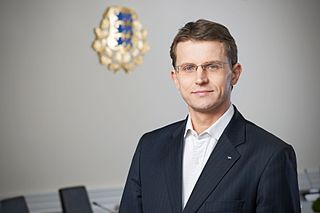
Ken-Marti Vaher is a leading member of the Estonian Pro Patria and Res Publica Union party.
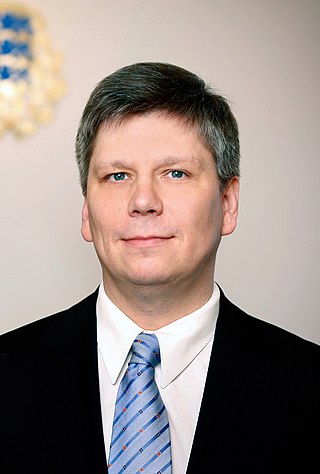
Siim Valmar Kiisler is an Estonian politician, a member of the Parempoolsed, former member of Isamaa.
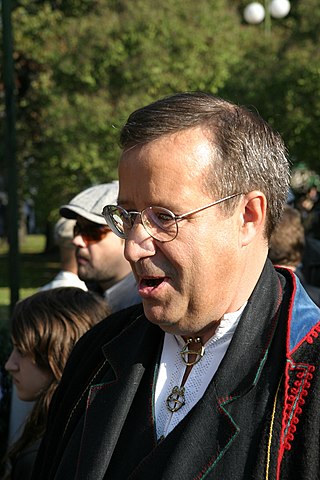
Estonian presidential elections, 2006 took place over four rounds, which were held on 28 and 29 August, and 23 September 2006. The first three rounds of the presidential election were held within the Riigikogu, which is Estonia's Parliament, as specified under electoral law. The two top candidates, Ene Ergma and Toomas Hendrik Ilves, were not elected because they did not obtain the required two-thirds of the votes in the Riigikogu.

Rein Aidma is an Estonian politician and pedagogue who was a member of the Riigikogu, representing the Estonian Reform Party from 2003 to 2015.

Mihhail Stalnuhhin, russified as Mikhail Anatolyevich Stalnukhin is an Estonian politician, representing the Estonian Centre Party from 1996 to 2022. He is a member of the Riigikogu, representing Ida-Virumaa. He was also the chairman of the Narva City Council in 2003–2011 and the chairman of the Riigikogu state budget control committee in 2017–2019.

Monika Haukanõmm is an Estonian social worker and politician who has been representing the Estonian Free Party in the Riigikogu since 2015.

Electoral district no. 1 is one of the 12 multi-member electoral districts of the Riigikogu, the national legislature of Estonia. The electoral district was established in 1995 following the re-organisation of the electoral districts in Tallinn. It is conterminous with the districts of Haabersti, Kristiine and Põhja-Tallinn in Tallinn. The district currently elects 10 of the 101 members of the Riigikogu using the open party-list proportional representation electoral system. At the 2019 parliamentary election it had 85,469 registered electors.
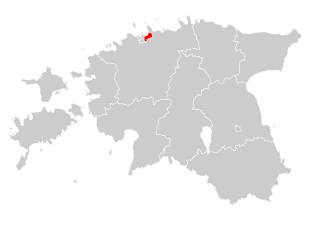
Electoral district no. 2 is one of the 12 multi-member electoral districts of the Riigikogu, the national legislature of Estonia. The electoral district was established in 1995 following the re-organisation of the electoral districts in Tallinn. It is conterminous with the districts of Kesklinn, Lasnamäe and Pirita in Tallinn. The district currently elects 13 of the 101 members of the Riigikogu using the open party-list proportional representation electoral system. At the 2019 parliamentary election it had 111,135 registered electors.
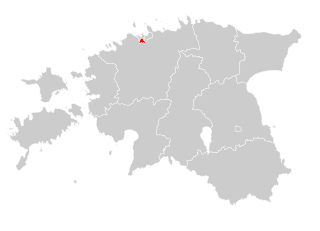
Electoral district no. 3 is one of the 12 multi-member electoral districts of the Riigikogu, the national legislature of Estonia. The electoral district was established in 1995 following the re-organisation of the electoral districts in Tallinn. It is conterminous with the districts of Mustamäe and Nõmme in Tallinn. The district currently elects eight of the 101 members of the Riigikogu using the open party-list proportional representation electoral system. At the 2019 parliamentary election it had 71,882 registered electors.

Electoral district no. 4 is one of the 12 multi-member electoral districts of the Riigikogu, the national legislature of Estonia. The district was established as electoral district no. 5 in 1992 when the Riigikogu was re-established following Estonia's independence from the Soviet Union. It was renamed electoral district no. 4 in 1995 following the re-organisation of electoral districts. It is conterminous with the counties of Harju and Rapla. The district currently elects 15 of the 101 members of the Riigikogu using the open party-list proportional representation electoral system. At the 2019 parliamentary election it had 133,437 registered electors.
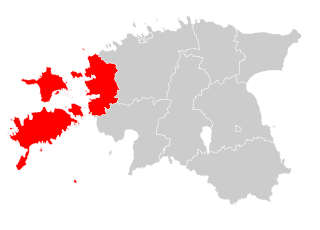
Electoral district no. 5 is one of the 12 multi-member electoral districts of the Riigikogu, the national legislature of Estonia. The district was established as electoral district no. 6 in 1992 when the Riigikogu was re-established following Estonia's independence from the Soviet Union. It was renamed electoral district no. 5 in 1995 following the re-organisation of electoral districts. It is conterminous with the counties of Hiiu, Lääne and Saare. The district currently elects six of the 101 members of the Riigikogu using the open party-list proportional representation electoral system. At the 2019 parliamentary election it had 51,093 registered electors.

Electoral district no. 6 is one of the 12 multi-member electoral districts of the Riigikogu, the national legislature of Estonia. The district was established in 2003 when the existing electoral district no. 6 was split into two. It is conterminous with the county of Lääne-Viru. The district currently elects five of the 101 members of the Riigikogu using the open party-list proportional representation electoral system. At the 2019 parliamentary election it had 44,583 registered electors.
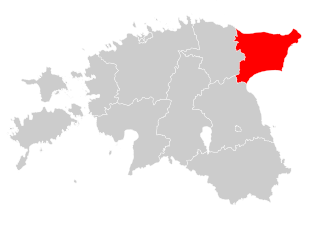
Electoral district no. 7 is one of the 12 multi-member electoral districts of the Riigikogu, the national legislature of Estonia. Established in 1992 when the Riigikogu was re-established following Estonia's independence from the Soviet Union, the district was abolished in 1995 following the re-organisation of electoral districts only to be re-established in 2003. It is conterminous with the county of Ida-Viru. The district currently elects seven of the 101 members of the Riigikogu using the open party-list proportional representation electoral system. At the 2019 parliamentary election it had 56,836 registered electors.
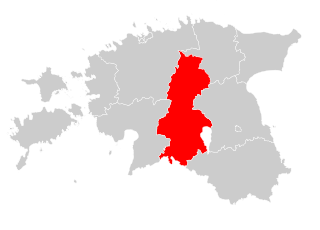
Electoral district no. 8 is one of the 12 multi-member electoral districts of the Riigikogu, the national legislature of Estonia. The district was established as electoral district no. 7 in 1995 following the re-organisation of electoral districts. It was renamed electoral district no. 8 in 2003 following another re-organisation of electoral districts. It is conterminous with the counties of Järva and Viljandi. The district currently elects seven of the 101 members of the Riigikogu using the open party-list proportional representation electoral system. At the 2019 parliamentary election it had 61,657 registered electors.

Electoral district no. 9 is one of the 12 multi-member electoral districts of the Riigikogu, the national legislature of Estonia. The district was established as electoral district no. 8 in 1995 following the re-organisation of electoral districts. It was renamed electoral district no. 9 in 2003 following another re-organisation of electoral districts. It is conterminous with the counties of Jõgeva and Tartu. The district currently elects seven of the 101 members of the Riigikogu using the open party-list proportional representation electoral system. At the 2019 parliamentary election it had 65,898 registered electors.
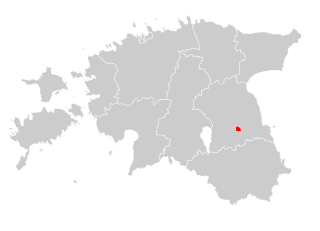
Electoral district no. 10 is one of the 12 multi-member electoral districts of the Riigikogu, the national legislature of Estonia. The district was established as electoral district no. 9 in 1995 following the re-organisation of electoral districts. It was renamed electoral district no. 10 in 2003 following another re-organisation of electoral districts. It is conterminous with the municipality of Tartu. The district currently elects eight of the 101 members of the Riigikogu using the open party-list proportional representation electoral system. At the 2019 parliamentary election it had 67,525 registered electors.

Electoral district no. 11 is one of the 12 multi-member electoral districts of the Riigikogu, the national legislature of Estonia. The district was established in 1992 when the Riigikogu was re-established following Estonia's independence from the Soviet Union. It was renamed electoral district no. 10 in 1995 following the re-organisation of electoral districts but reverted to electoral district no. 11 in 2003. It is conterminous with the counties of Põlva, Valga and Võru. The district currently elects eight of the 101 members of the Riigikogu using the open party-list proportional representation electoral system. At the 2019 parliamentary election it had 70,706 registered electors.

Electoral district no. 12 is one of the 12 multi-member electoral districts of the Riigikogu, the national legislature of Estonia. The district was established in 1992 when the Riigikogu was re-established following Estonia's independence from the Soviet Union. It was renamed electoral district no. 11 in 1995 following the re-organisation of electoral districts but reverted to electoral district no. 12 in 2003. It is conterminous with the county of Pärnu. The district currently elects seven of the 101 members of the Riigikogu using the open party-list proportional representation electoral system. At the 2019 parliamentary election it had 66,852 registered electors.



















